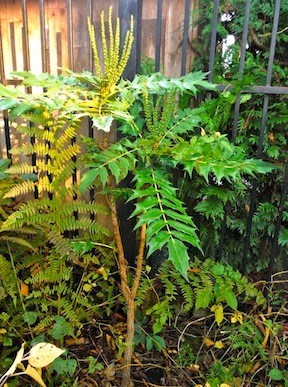These mahonias belong in all but the smallest garden. Statuesque. Evergreen. November to December spikes of soft yellow flowers loved by native hummingbirds. Colourful bluish-purple edible berries in fall, but usually only used in jellies. Holly-like foliage that can act as an effective barrier, but not as messy as holly. What's not to like?
Want a dramatic effect along a north-facing wall? Plant three to five of these in a row, or plant one or two behind a perimeter tree by a fence. They will keep their columnar profile. The only direct summer sun on the one pictured is in late afternoon. Now that the cherry leaves have fallen, 'Charity' begins to glow as blooms develop into the darkening days.
Mahonias are tough plants. Easily grown in full sun to dappled shade, they tolerate our sandy and clay soils. To boot, they are drought-tolerant. Prune off any broken or damaged branches in spring, or prune to promote more branching and a fuller shape with more blossoms.
Editor’s note: This is the latest installment of the ‘meet series’ of columns and articles from the South Delta Garden Club, a weekly online feature in the Delta Optimist.



